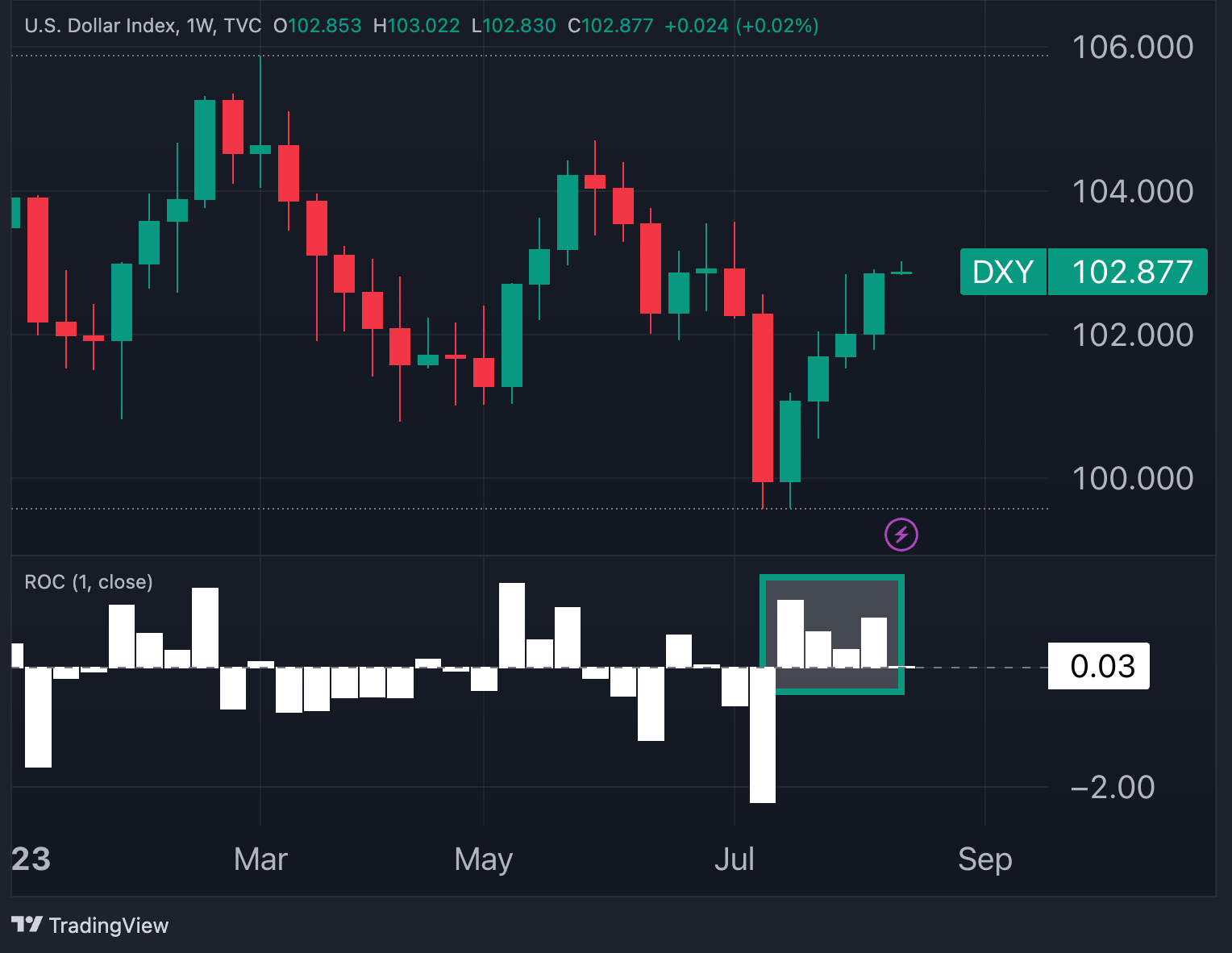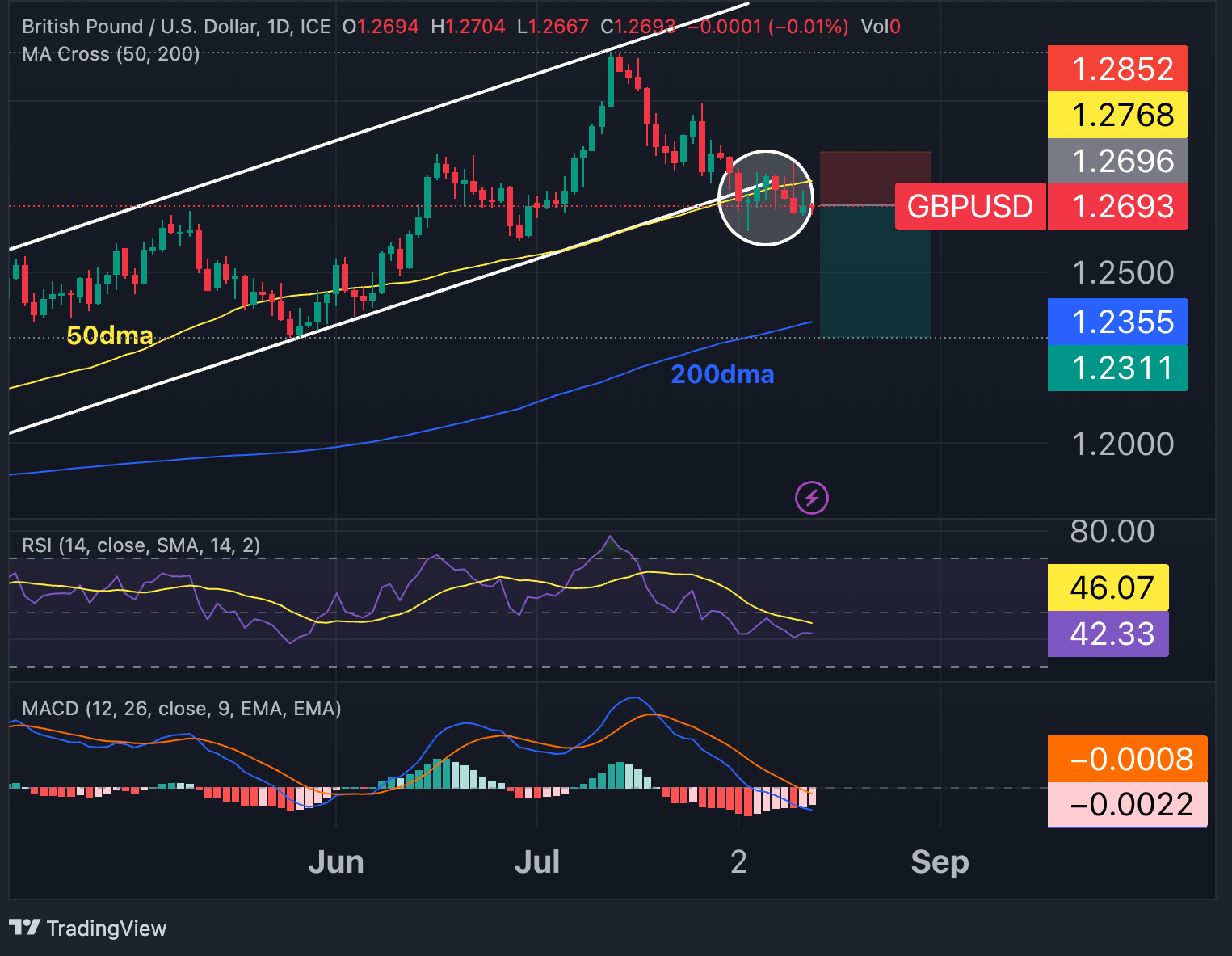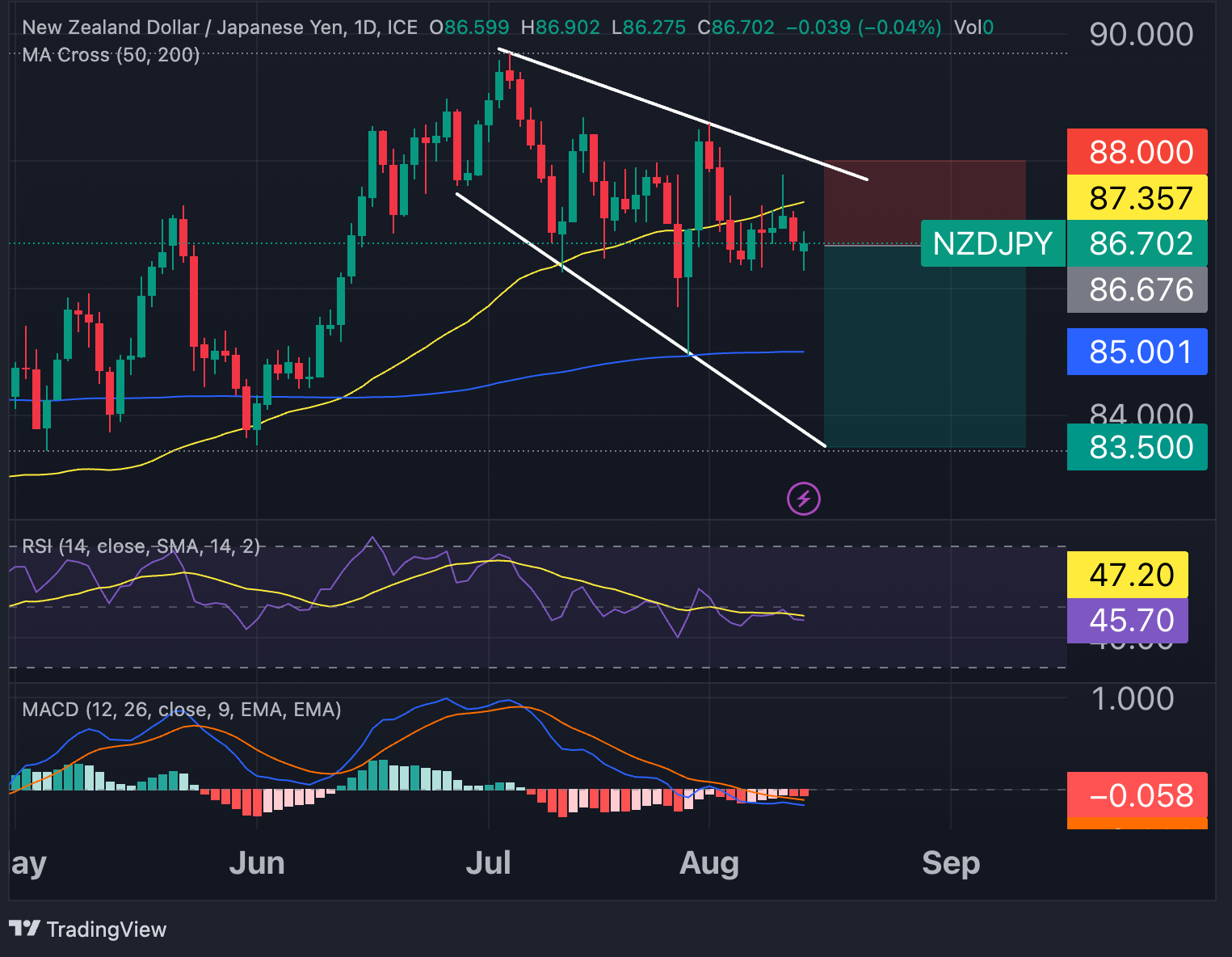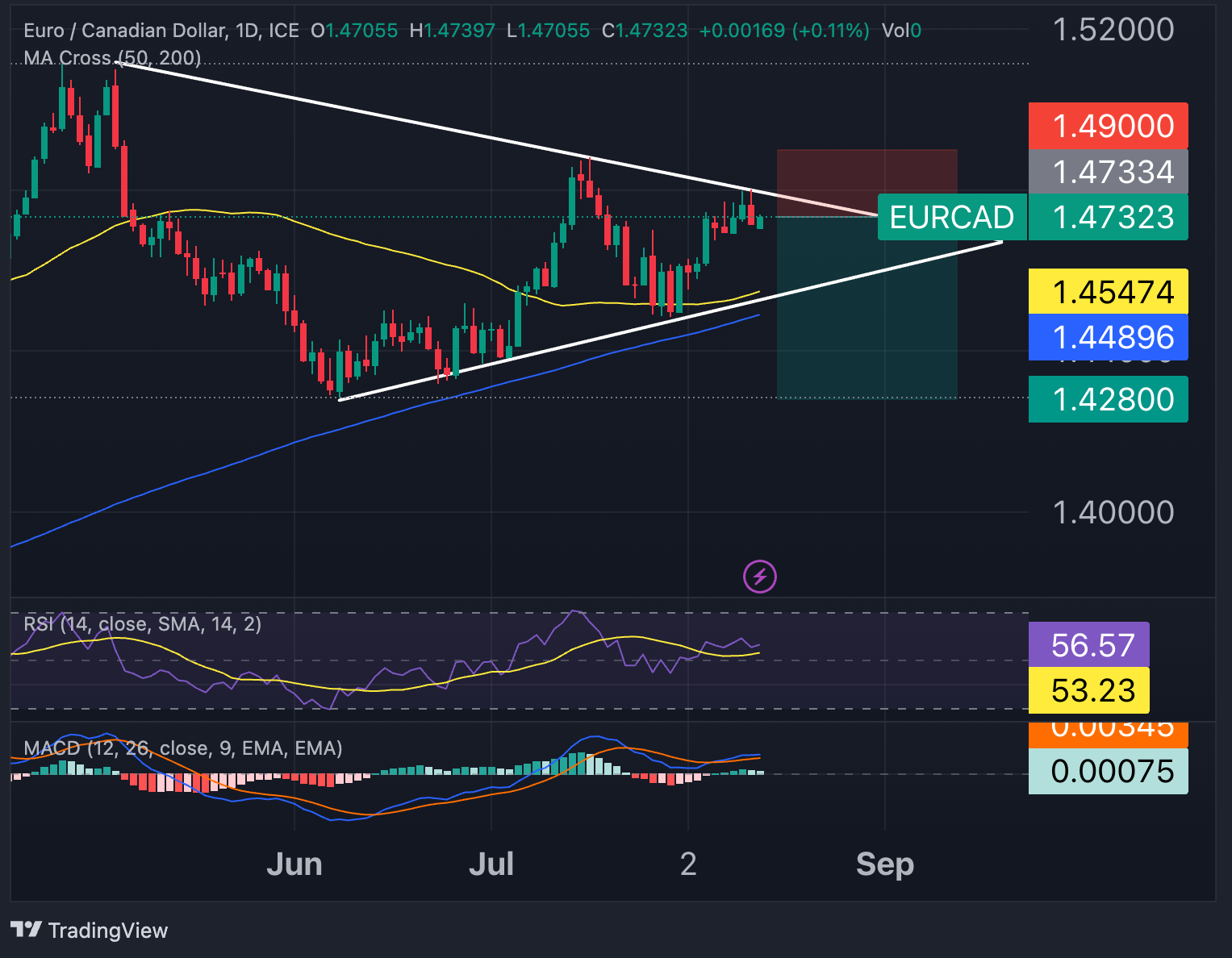The past week showcased the dollar as the star performer in the FX market, drawing in safe-haven seekers and surging ahead against all other major currencies.
Market Review: What Happened
The U.S. Dollar Index (DXY) notched its first four-week winning streak since January 2023, riding the wave of rising Treasury yields.
In July, U.S. consumer inflation ticked up to 3.2% annually, a modest increase from June's 3%, breaking a streak of twelve consecutive declines. However, it fell slightly short of the 3.3% expectations. The real twist was seen in producer prices, which, after hitting a nearly three-year low, surged more than anticipated in July. This unexpected spike has sparked concerns about the reawakening of price pressures.
Simultaneously, energy commodities are making a comeback, with oil and natural gas climbing, while equities offer more clues about a possible trend reversal.
The Nasdaq 100, housing the largest U.S. tech stocks, breached the 50-day moving average support, making waves in the stock market.
Risk off sentiment has exacerbated risk-related currencies, primarily hitting Swedish krona (SEK) and Norwegian krone (NOK), but also Australian dollar (AUD) and New Zealand dollar (NZD). The flight to safety sentiment has particularly impacted risk-linked currencies, dealing a blow to the Swedish krona (SEK) and the Norwegian krone (NOK).
The Australian dollar (AUD) and the New Zealand dollar (NZD) have also faced pressure as they begin the week with grim data on Chinese credit. Despite China officially entered deflation last month, Chinese banks extended only CNY 345.9 billion in new yuan loans, a far cry from market forecasts of CNY 800 billion, marking the lowest since November 2009.
This week, all eyes are locked onto the FOMC minutes from the Federal Reserve meeting held on July 26, during which policymakers raised rates by 0.25%, bringing them to the 5.25-5.5% range. Speculation will run rife as the market tries to gauge whether this might be the final hike or not. Fed futures suggest a nearly 90% likelihood of the Fed keeping rates unchanged in September.
Forex Market: Key Events Of The Week
United States:
- FOMC Minutes (Wednesday)
- Retail sales for July (Monday): Economists expect a 0.4% monthly increase, accelerating from 0.2% in June.
- Fed’s Kashkari speaks (Monday).
Euro Area:
- ZEW Economic sentiment (Tuesday)
- GDP Growth Rate 2nd estimate (Wednesday): Preliminary estimates showed a 0.3% quarter-on-quarter annualized growth rate.
- Balance of trade (Thursday)
- July’s inflation rate (final reading) (Friday): Preliminary estimates showed a slowdown in the annual inflation rate from 5.5% to 5.3% in July.
United Kingdom:
- Inflation rate (Wednesday): Economists predict a decline in the annual inflation rate to 6.8% in July, from 7.9% in June.
- Unemployment rate (Tuesday): The jobless rate is expected to remain steady at 4%.
- Retail sales (Friday): Analysts’ consensus expect a 0.5% drop in July’s retail sales.
Other Data To Follow:
- Reserve Bank of Australia (RBA) Minutes (Tuesday):
Canada’s inflation rate (Tuesday): 3% expected, 2.8% previous.
- Reserve Bank of New Zealand (RBNZ) interest rate decision (Wednesday): Markets expect the RBNZ to stay on hold at 5.5%.
- Norges Bank interest rate decision (Thursday): Markets predict a 0.25% hike to 4%, the highest since November 2008.
- Japan’s inflation rate (Thursday): 3.1% expected, 3.3% previous.
Chart Of The Week: Dollar Is On A 4-Week Winning Streak

New Trades for The Week
Short GBP/USD
- Entry: 1.2690
- Take Profit: 1.2310
- Stop Loss: 1.2850
- Risk/Reward Ratio: 2.4

Fundamental View: UK inflation is anticipated to dip to 6.8% in July, reaching its lowest point since February 2022, prior to the Russia's invasion of Ukraine. If this projection holds true or falls below expectations, it could effectively relieve the pressure for future rate hikes at the Bank of England, leading to a reduction in support for the pound.
In the minutes from the latest FOMC meeting, policymakers might keep the door open for potential additional rate hikes, considering the robustness of the US economy and labor market. Should the global risk-off sentiment gather more momentum in the upcoming week, this trend would further favor buying flows into the USD and selling pressures on the GBP.
Technical View: The GBP/USD pair has experienced a significant downward shift, breaching below the crucial support of the 50-day moving average that had been a solid foundation for the pair since early June. This decline also coincides with the abandonment of the bullish channel that had been established since March.
With the current trend displaying a four-week consecutive slide, it's evident that bears have taken control of the GBP/USD in the short term. Key technical indicators confirm this bearish momentum, with the Relative Strength Index (RSI) plunging downward and the Moving Average Convergence Divergence (MACD) signaling a similar pattern.
A noteworthy short-term target lies in the range of 1.23 to 1.2310, which aligns with the May lows, just slightly below the 200-day moving average. A stop loss at 1.2850 should provide protection in case of bullish surprises on the UK inflation front or dovish hints in the FOMC minutes.
Short NZD/JPY:
- Entry: 86.70
- Take Profit: 83.50
- Stop Loss: 88.00
- Risk/Reward Ratio: 2.4

Fundamental View: The Reserve Bank of New Zealand (RBNZ) is anticipated to maintain its current interest rates in its upcoming Wednesday meeting. This decision could serve as an indicator that the tightening cycle might be reaching its conclusion. The prevailing risk-off sentiment in equity markets coupled with lackluster data emerging from China may continue adding downward pressure on the New Zealand dollar.
The upcoming inflation data release is a notable risk event for the Japanese Yen. This event could potentially ignite speculation regarding the trajectory of yields in Japanese Government Bonds. Although the headline inflation rate is projected to slightly decline from 3.3% to 3.1%, the core inflation figure, which excludes energy and food components, is expected to exhibit a marginal uptick from 4.2% to 4.3%, which could add hawkish pressures on the Bank of Japan.
Technical View: The NZD/JPY pair has remained confined within a narrow trading range over the past 8 sessions. Despite this consolidation, it's noteworthy that the pair has been forming lower highs since early June, which raises the possibility of the beginning stages of a bearish trend.
Key technical indicators support this potential bearish outlook. The RSI has dipped below the 50 mark, while the MACD has crossed below the zero line, signaling the emergence of bearish momentum.
For short-term bears, a compelling target lies at 83.50. This level implies a potential breakdown below the 200-day moving average, which could set the stage for a retest of the lows observed in both June and May. Stop loss could be set at the psychological 88 mark, which would also imply a breakout of the declining wedge pattern.
Short EUR/CAD:
- Entry: 1.4730
- Take Profit: 1.4280
- Stop Loss: 1.49
- Risk/Reward Ratio: 2.7

Fundamental View: The Canadian dollar benefits from the upward trajectory of energy prices, acting as a protective cushion, unless unforeseen spikes in market volatility disrupt this stability.
In Canada, the inflation rate is projected to rise again in July to 3%, which could reignite optimism among CAD bulls and trigger a more hawkish stance from the Bank of Canada.
Conversely, the euro could face confirmation of a waning inflation momentum and a slowdown in the Eurozone's economic sentiment gauge.
Technical View: The EUR/CAD pair slightly retraced after hitting resistance from the May-July bearish line. This movement has given rise to the formation of a triangle pattern.
A significant support level to monitor lies at the 1.45 mark, aligning with both the lower boundary of the triangle and the 50-day and 200-day moving averages. The breach of this support could potentially trigger a more substantial decline for the pair, potentially reaching as low as 1.4280, which corresponds to the lows registered in June.
Trades from past weeks:
- Long U.S. Dollar Index (DXY):
- Opened on August 7 at 102.19
- Take Profit: 105.5
- Stop Loss: 100.90
- Profit & Loss: +0.6%
- Short XAG/USD (Silver):
- Opened on August 7 at 23.46
- Take Profit: 21.50
- Stop Loss: 24.32
- Profit & Loss: +3.2%
- Long USD/SEK:
- Opened on August 7 at 10.60
- Take Profit: 11.20
- Stop Loss: 10.46
- Profit & Loss: +2.1%
- Short EUR/USD:
- Opened on July 24 at 1.1085
- Take Profit: 1.0880
- Stop Loss: 1.1150
- Profit & Loss: +1.2%
- Short NZD/CAD:
- Opened on July 24 at 0.8174
- Take Profit: 0.7975
- Stop Loss: 0.8263
- Profit & Loss: +1.5%
- Long USD/CHF:
- Opened on July 17 at 0.86
- Take Profit: 0.89
- Stop Loss: 0.85
- Profit & Loss: +1.8%
- Long CHF/JPY:
- Opened on June 19 at 158.58
- Take Profit: 171.62
- Stop Loss: 152.5
- Profit & Loss: +4.3%
- Long EUR/JPY:
- Opened on May 8 at 149.16
- Take Profit: 160
- Stop Loss: 142
- Profit & Loss: +6.5%




